Michigan vegetable crop report – July 30, 2025
Cooler days are ahead as harvest ramps up.
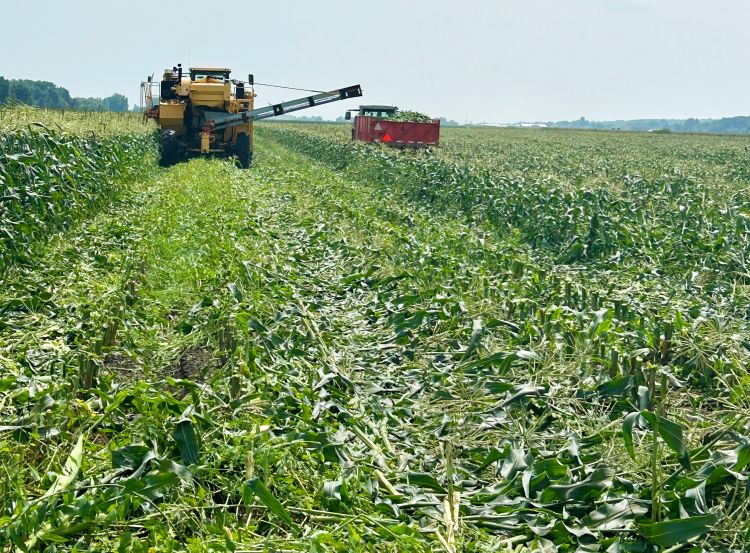
Weather
Temperatures this past week ranged from 1-6 degrees Fahrenheit above normal with higher temperatures to the west. Degree day totals are one-plus weeks ahead of normal in the southern Lower Peninsula, with surpluses decreasing to the north.
Rainfall ranged from 0.25 to 2 two inches in far southern Michigan and the Keweenaw Peninsula. West central and southwest Michigan’s rainfall was 50% of normal for the past two months. The Saginaw Valley area thankfully got some relief with rain.
This week’s forecast calls for:
- Partly sunny and cooler Wednesday, July 30. Scattered showers and thunderstorms developing south during the afternoon and continuing overnight into Thursday morning across southern sections. Decreasing clouds, cooler and less humid elsewhere Thursday. Fair and seasonably warm Friday through Sunday. Warmer with a chance of showers Monday and Tuesday.
- Weekly precipitation ranging from nothing to an inch with more rain to the south. Dry areas in southwest Michigan may get some relief.
- High temperatures from the 70s to low 80s Wednesday, in the 70s Thursday through Sunday, warming back to the 80s early next week. Lows generally from the 40s N to 50s S through the weekend.
- Medium range outlooks call for a return of warmer than normal mean temperatures and near to above normal rainfall totals during the second week of August.
Cybercrime survey
If you have been affected by cybercrime or are nervous about the potential for it, please take this very short survey regarding cybercrime experiences. The survey/research is being led by Tom Holt, professor at the School of Criminal Justice at Michigan State University (MSU). For a Michigan Farm News story about the study, see “MSU cybercrime survey to help MI farmers before the hack happens.”
Crop updates
Asparagus
It’s been (mostly) dry as a bone in west central Michigan with some spotty rainclouds this Monday, July 28, dropping nice totals in some townships but not others. Despite limited rain, jungle-like dewpoints accelerated disease severity value (DSV) accumulation compared to previous weeks. Between 10-15 DSV accumulated between July 22-28 at nine sensors Michigan State University Extension and partners are monitoring in Oceana and Mason County asparagus. A fungicide application would have been indicated for Monday, July 28, if nothing had been applied since July 16-20 (assuming a 15 DSV interval).
Cucurbits
Cucumber and summer squash harvest continues. The pickling cucumber harvest has begun on the east side of the state. Melons are being harvested on some farms. Pumpkin fruit is developing. Powdery mildew has been reported in the northeast side of the state.
Downy mildew continues to be detected on cucumbers across the state. The early alert spore trapping network indicates the pathogen is being frequently detected at all locations. Check out the latest downy mildew updates on the Hausbeck Lab website. While the recent hot and dry weather does not favor downy mildew, it is widespread in the state and will progress rapidly once the weather cools, especially if accompanied by rain showers. Cucumber beetles and squash bugs can be found on plants.
Bacterial leaf spot in pumpkins has been a sporadic occurrence over recent years. In some instances, the incidence and severity in a particular field can be damaging. However, since bacterial leaf spots can resemble other leaf spots caused by fungi, it is important to get a sample to a diagnostic laboratory. The spread of the bacterial leaf spot pathogen to new leaves can be slowed by frequent applications of copper-based products. In contrast, if the leaf spotting is caused by a fungal pathogen, then copper will not be especially helpful and more targeted fungicides may be needed to protect the plant.
Brassicas and greens
Black rot has been reported in cabbage, Brussel sprouts and broccoli on several farms. Read more information on black rot from the University of Minnesota Extension. Elevated numbers of cabbage white butterflies (imported cabbage worm adults) are being reported on the eastern side of the state. Check out this Michigan State University (MSU) Extension bulletin, “Caterpillar Pests in Cole Crops,” for a refresher on some of the main culprits.
Fruiting vegetables
Field harvest has begun for many growers. Tomato hornworms and spider mites have been reported. Japanese beetles have been seen on crops. Recent heat followed by heavy rains has led to increased reports of tomato splitting and cracking. Some cracks may be deep, allowing pathogens to enter the fruit and cause fruit rot.
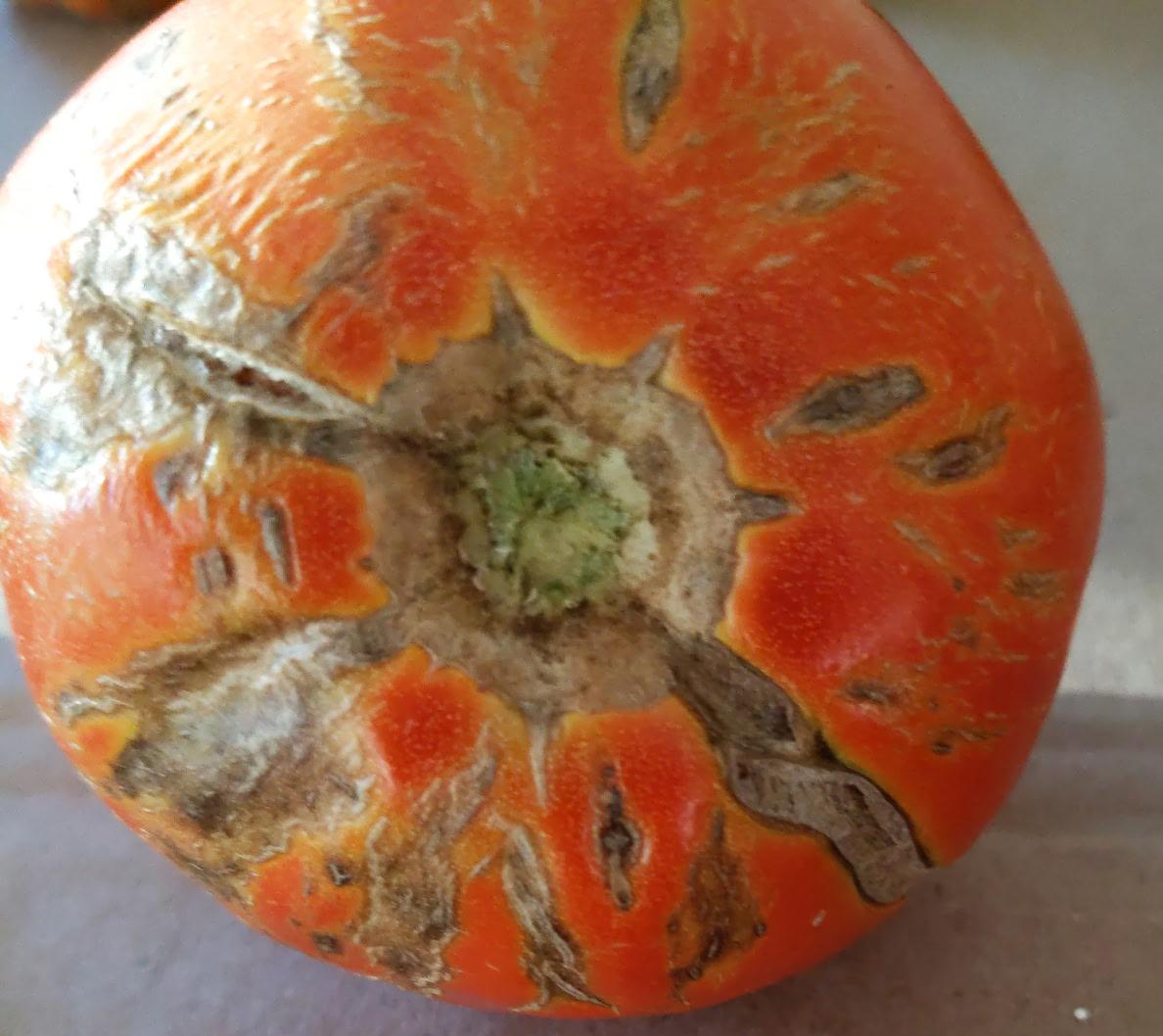
Onions and garlic
Garlic harvest is in full swing. Minor nematode damage has been reported on harvested garlic.
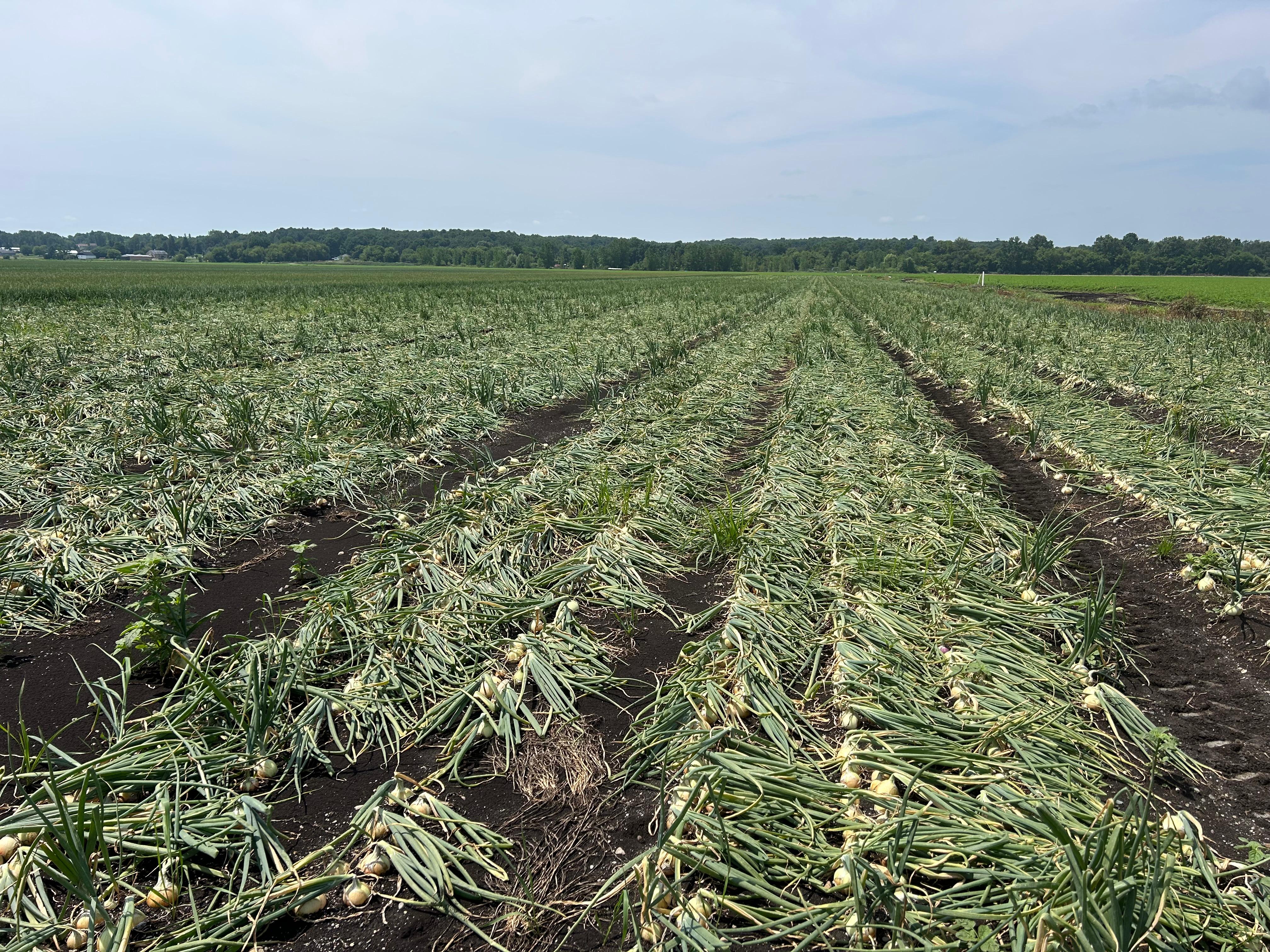
Carrots
Michigan’s carrot producers for fresh and processing markets are threatened by foliar blights each year. When the fungi Alternaria dauci and Cercospora carotae blight the leaves and petioles (see images at the end of this section), yields are reduced. If the petioles become weakened and die, a mechanical harvester cannot be used to pull the carrots out of the ground.
It is not unusual for both fungal pathogens to develop in a carrot crop grown for processing, especially late in the season. The Alternaria pathogen infects older carrot foliage that is often under the canopy and near the soil. This pathogen causes lesions that are brown, sometimes with a yellow halo but do not have a specific shape. The lesions often start at the edge of the carrot leaf and as they advance, they cause more blighting.
The Cercospora pathogen is different from the Alternaria pathogen in that it infects young leaves. The Cercospora pathogen causes round lesions with a dark rim and a lighter, tan or gray center.
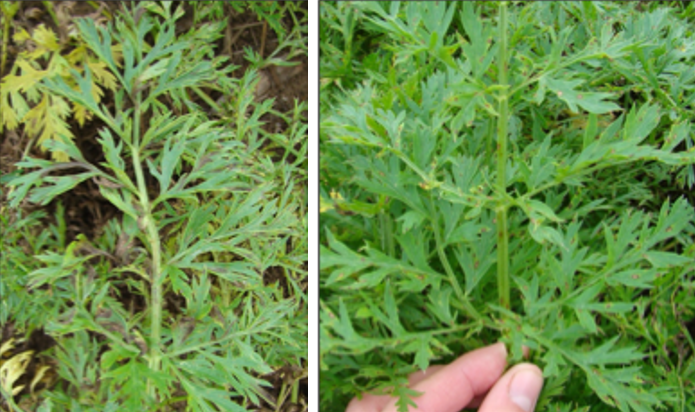
Disease forecasters can play an important role in integrated pest management systems for carrots by alerting growers when weather conditions are favorable for disease development. Fungicide sprays are often needed but vary from year to year based on the environment. The forecasting system, TOM-CAST, has been adapted to successfully predict foliar blight in Michigan’s carrots and is used by growers targeting the processing industry. By timing fungicide applications for optimum efficacy, growers typically may be able make fewer total applications without sacrificing disease control. This can be especially true in a year that is dry, which typically doesn’t favor the development of foliar pathogens.
When choosing fungicides and putting together an overall protection strategy, it is important to alternate active ingredients so that the pathogens that cause foliar blight do not have a chance to adapt to a particular fungicide and become resistant. The fungicide product label includes a FRAC code, which is an alphanumeric code assigned by the Fungicide Resistance Action Committee (FRAC), and is based on the mode of action of the active ingredient. Fungicides that are labeled for use against foliar blight, have a similar mode of action, which is determined by them having the same FRAC code. Developing a protection program that ensures fungicides with different FRAC codes are used is the best way to keep all the fungicide tools working well.
Thirteen DSVs accumulated between July 22-28 at two Oceana County carrot fields MSU is monitoring. A fungicide application would have been indicated for Monday, July 28, if nothing had been applied since July 19 (assuming a 15 DSV interval).
Sweet corn
Harvest is in full swing. Corn leaf aphids can be found. While corn earworm numbers have remained low in the eastern part of the state, multiple growers have reported corn borer damage in harvested crops.
Corn earworm captures were variable across the MSU trapping network this week.
Table 1. Corn earworm captures. Total in trap for week1 (avg # per night2).
| Week | Saginaw Co.3 | Oceana Co.4 | Ottawa Co.4 | Allegan Co.3 | Monroe Co.3 | Genesee Co.3 | Lapeer Co.3 | Lapeer Co.3 |
|---|---|---|---|---|---|---|---|---|
| 30-Jun | - | 42 (7.0) | 265 (33.1) | - | - | - | - | - |
| 7-Jul | 3 (0.4) | 122 (17.4) | 30 (6.0) | - | - | - | - | - |
| 16-Jul | 6 (0.9) | 76 (10.9) | 4 (0.6) | - | 6 (0.86) | 2 (0.3) | 9 (1.3) | 2 (0.3) |
| 23-Jul | 0 (0.0) | 13 (1.9) | 1 (0.1) | - | - | 0 (0.0) | 0 (0.0) | 0 (0.0) |
| 30-Jul | 1 (0.1) | 4 (0.6) | 21 (4.2) | 8 (2.0) | 0 (0.0) | 0 (0.0) | 0 (0.0) | 0 |
1Total number collected since last trap check; 2The total number divided by the number of nights since the last trap check; 3Cloth Heliothis traps track trends but catch less moths overall; 4Wire Harstack traps capture more moths.
To our south, for the past week corn earworm numbers were mostly in the single digits in the trapping network maintained by Purdue University with low numbers in Ohio State University’s network. Insect Forecast predicts a moderate of additional migration through tomorrow, with highest risk in west central and southwest Michigan. Check your traps!
Western bean cutworm numbers are elevated at two locations MSU is monitoring, though they declined in Ottawa County. Numbers are high but possibly past peak in Ohio State University’s trapping network.
Table 2. Western bean cutworm captures. Total in trap for week1 (avg # per night2).
| Week | Genesee Co. | Oceana Co. | Ottawa Co. |
|---|---|---|---|
| 30-Jun | - | 0 (0.0) | 16 (2.0) |
| 7-Jul | - | 13 (1.8) | 17 (3.4) |
| 16-Jul | 2 (0.3) | 54 (7.7) | 67 (9.6) |
| 23-Jul | 6 (0.86) | 68 ( 9.7) | 316 (35.1) |
| 30-Jul | - | 95 (13.6) | 70 (14) |
1Total number collected since last trap check; 2The total number divided by the number of nights since the last trap check.
Corn leaf aphid populations were present in sweet corn tassels at some west Michigan locations. According to “Managing Insects in Commercially Grown Sweet Corn” from Purdue University, corn leaf aphid mainly causes issues when sticky honeydew in tassels interferes with pollination. This resource suggests the “rule of 50s:” pollination may be impacted when 50% of plants have over 50 aphids, and pollination is less than 50% complete. Lady bugs were reproducing like mad as well, and beneficials may help clean up infestations in the long run.
Bifenthrin (Brigade, Elevest, etc.) should kill corn leaf aphid and mites and pull double duty as a corn earworm spray. Lannate and Assail should also help with aphids but will have only so-so (Lannate) and no (Assail) worm activity. Broad-spectrum insecticides like Brigade and Lannate will also kill beneficials, which can lead to pest rebounds in the longer term.
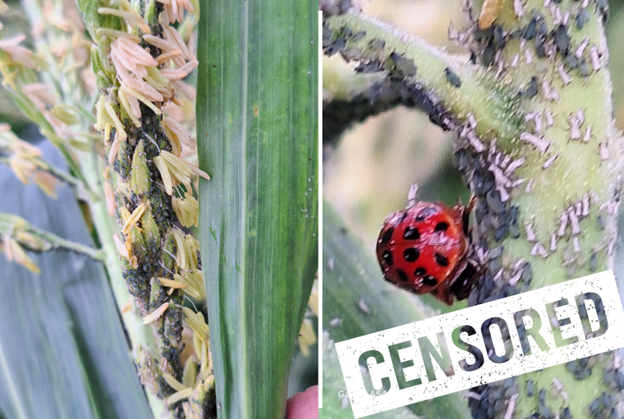
Produce Food Safety On-Farm Readiness Reviews
Schedule an On-Farm Readiness Review today for a two-hour educational visit that takes place during the harvest season and is meant to be casual and low stress. Everything discussed during an On-Farm Readiness Review is confidential and focuses on ways to reduce risks in relation to produce safety. There is no pressure to take our advice either, we are just here to support you in your produce safety efforts.
On-farm soil moisture monitoring research opportunity
MSU researchers are looking for 20 farms to install soil moisture probes in up to two fields. Cooperators get access to real-time data for both monitoring stations for three growing seasons (fall 2025-fall 2028). Refer to the flier for more details.
Reach out to Alex Kuhl (kuhlalex@msu.edu) if you might be interested or have questions.
Events
- August 1, 9 a.m.-2:30 p.m., Summer Irrigation Workshop
- August 5, 12-1 p.m., Seed Treatment Webinar Series
- August 7, 7-8 a.m., Field Crops Virtual Breakfast Series: Drones (RUP/CCA)
- August 7, 10 a.m.-2 p.m., Weed Management Field Day at Full Hollow Farm
- August 12, 12-1 p.m., Seed Treatment Webinar Series
- August 15, 8:30-11:30 a.m., Farming Forward succession planning seminar at Saginaw Valley Research and Extension Center
- August 18 – 19, Northern Michigan Small Farm Conference
- August 19, 12-1 p.m., Seed Treatment Webinar Series
- August 20, 8 a.m.-3:30 p.m., 2025 Midwest Mechanical Weed Control Field Day
- August 20, 10 a.m.-2 p.m., Organic Vegetable Pest Management Field Day
- August 26, 12-1 p.m., Seed Treatment Webinar Series
- September 4, 5-8 p.m., Cover Crop Workshop at the Saginaw Research and Extension Center
- October 11, 1-3 p.m., Farm Field Day with Fisheye Farm
- October 21, 12-1 p.m., What are Your Farm Certification Goals? - TOPP Online Webinar
- October 28, 12-1 p.m., Organic Market Premium - How Much Can I Expect to Get for My Products? - TOPP Online Webinar
- November 4, 12-1 p.m., How to Make Money in Organic Farming - TOPP Online Webinar
- December 9-11, Great Lakes Expo
This work is supported by the Crop Protection and Pest Management Program [grant no 2024-70006-43569] from the USDA National Institute of Food and Agriculture. Any opinions, findings, conclusions, or recommendations expressed in this publication are those of the author(s) and do not necessarily reflect the view of the U.S. Department of Agriculture.



 Print
Print Email
Email

